Tia Bodington knew she needed to make a change. With a previous mindset that anything above a 5k was too long, Tia decided to plunge into her first ultra. The year was 2000 and Tia was going to run the Miwok 100k Trail Race. She prepared for 62 miles of contemplations on her two daughters, her school classes, and her job. Instead, six hours into the race she realized: “I was completely in the present moment. No past and no future, just the present.” Her brain was off. Mist wet her face and flowers crunched under her feet with each step.
“I let everything go,” Tia said. “It was the most relaxing day of my life.”
Zen? Flow? She still doesn’t know exactly what happened out there, but while sitting among the finishers afterward, she knew she had to go back.
Tia recently celebrated her 59th birthday. She technically lives in Ashland, Oregon, but from traveling for school, work, running, and visiting her two grown daughters who live in Texas and Colorado, let’s just say that Tia spends most of her time ‘out West.’ A change she indeed has had, Tia now keeps distance running close to her heart and near the forefront of her life.
Growing up in California, north of the Golden Gate Bridge, Tia had what she called “firm walking only” parents. “For years I walked to school every day, and in high school the school was three miles away,” she said. “You would think when I got older I would hate walking and exercise, but I still love it!”
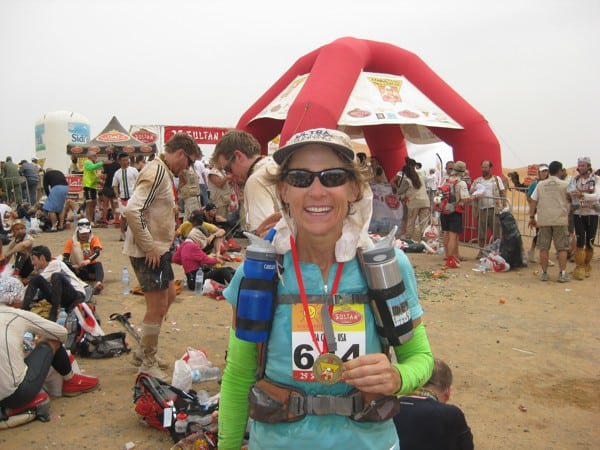
Tia after finishing the 2010 Marathon des Sables. Photo courtesy of Tia Bodington.
After she was unsuccessful at making the the gymnastics team, someone politely suggested she might be better at track. She agreed to try it, and ended up attending the girls state track meet for the 80-yard hurdles event. That year, 1974, was the first year girls were even allowed to compete in a state meet and to race the one-mile distance following the 1974 passage of Title IX.
In college at UCLA, Tia walked onto the hurdles team, and after two years she transferred to UC Berkeley and joined the track team there. During her senior year, the track team had very little money and coaching, but it was the year, according to Tia, that Title IX was finally adopted on Berkeley’s campus.
“Senior year we had a new track put in, and the first meet of the year was going to be for the men’s team. They ignored the women,” she said. “So, three of us marched into the athletic director’s office and demanded to be able to run. It was the start of women showing they wanted to be involved and wanted to be athletes.”
Tia graduated college with a French degree and became a French translator for a bank in California.

Tia running the Firetrails 50 Mile. Photo: Pete Beck
Over her early adulthood years, she traveled with her husband (they are no longer together) and her two daughters and competed in fast 5k races. In 2000, she did her first distance race, the Death Valley Marathon. She had a blast, she said, and blazed through the finish line in third place. Two months later, with just one 20-mile training run to prepare, she found herself on the trails of the Miwok 100k, her first ultra. Then, she won the Tamalpa Headlands 50k in August.
Wow, okay, maybe this is my sport, she said to herself back then.
In 2001, Tia was accepted into Western States and finished it, despite having serious kidney problems. It was not her best race, she said, but it was her first 100-mile experience and it has eventually led to her to now being on the board of the race.
A year later, the movie “Running on the Sun: The Badwater 135” was just so insane and extreme enough that it inspired Tia to sign up. She ran the race on a stress fracture that resulted in a six-month break after the race. “I learned how to swim and earned my teaching credentials for teaching a second language,” she said. “I went from the hospital straight to the building to sign up for the class.”
Wallowing is never an option for Tia. “You get 24 hours to wallow, then you have to move on,” she said. “After 24 hours you work out what’s next.”

Tia with Bree Lambert who finished second at last year’s Miwok. Photo courtesy of Bree Lambert.
In 2004, Tia was a single parent, running a few ultras, and teaching on the side. It was also around this time Tia became the race director of her first beloved ultra, the Miwok 100k. By then she had run the race a few times and knew the then race director, John Medinger, and his wife pretty well. Since then, the race has changed Tia, becoming a regular part of her almost-daily life, and she has also changed the race some, too.
Recycling and decreasing trash production at trail races is something Tia is passionate about, and Tia has worked to lessen the environmental impact of Miwok a little bit every year. So influential was the concept of low-impact trail racing on Tia that she’s pursuing additional education in it. Two and half years ago, Tia decided to obtain her MBA to learn more about business. At this time Tia was spending 60 hours a week as one of the editors of UltraRunning Magazine, in addition to fulfilling her duties as race director and single mother. When she decided to take on the MBA, she had to drop her position as editor in hopes of working with races on sustainability issues. “What I want to do is work with races to reduce their footprint,” she said.
She is currently enrolled in Southern Oregon University and will earn her degree in March of 2016. Since beginning her charge on reducing the impact ultras leave have on the environment, she has decreased the amount of garbage collected at Miwok each year from a 10-yard-long dumpster to a two-yard box.
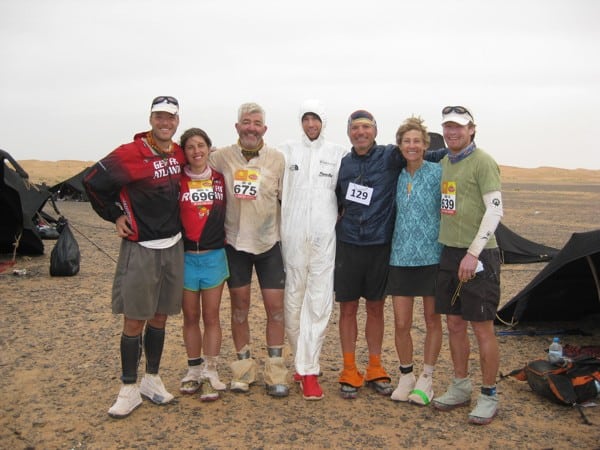
Tia and her tentmates at the 2010 Marathon des Sables. From left to right: Lane Vogel, Jennifer Vogel, Toby Luxford, Michael Wardian, John Callos, Tia, and Jay Batchen. Photo courtesy of Tia Bodington.
She speaks on sustainability to conferences, after having used her own race as a guinea pig. “One of the things I talk about is going cupless,” she said. Whatever sustainability option someone chooses, Tia says, it must work for the runners. As both a runner and race director, Tia thinks runners have one job: to get to the finish. “They should not have to ask where they should put a banana peel.”
During Miwok, Tia has one main volunteer at each of her aid stations, called the waste manager, and they are in charge of the trash and recycling. “The volunteer takes all trash from the runner to the correct bin so that the runner doesn’t have to worry about it at mile 58,” she said.
Tia says she owes a lot to her volunteer brigade. “It has helped me do more directing and not thinking about everything,” she said. Her team of helpers, Ana Braga-Levaggi, Ken Preston, Stan Jensen, and Jim Richards, are her details people. “They make the decisions for what is best for the runners, and they are usually right!”
Jensen, who we profiled in last month’s WeRunFar article, is one of Tia’s regular volunteers. “Tia is extremely well organized and always appears unstressed,” he said. “On race day, she’s always chatting with runners before the start and trying to greet all the finishers, too. Her volunteers know they’re appreciated and know what they need to do for the runners.”
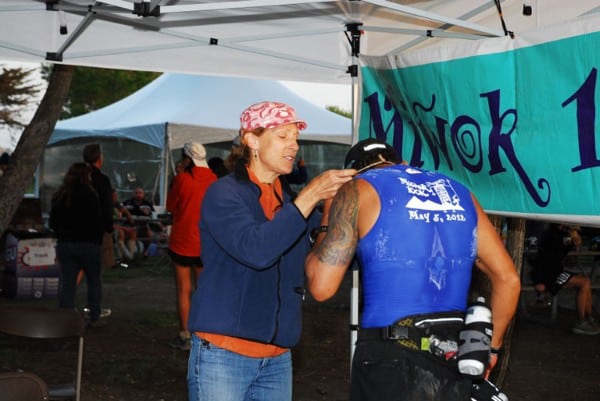
Tia placing a medal around the neck of a Miwok 100k finisher. Photo: Dan Gomez
Her relationships with volunteers are some of the strongest ties she has with people. Some people have been helping out the race for 20 years, just helping not racing, she told me. One of Tia’s happiest race-directing memories is about a couple who met while volunteering at Miwok. Aid-station chief Fred Liebes and volunteer Charlene Bayles met while helping out at the race, and recently were married on the trail. “The volunteers have so much dedication for the race,” she said. “They are my focus for creating an experience for them and the runners.”
The hardest part about directing, which she says most race directors will agree on, is dealing with permits and negotiating the park administrations. The race intertwines through multiple park systems, is quite long, and has runners out in the dark, which all add complexity to the permitting process.
Negotiating permits begins months before the May race and last-minute problems, like weather, force Tia to make adjustments to the race. In previous years, the start and finish locales have changed and one year due to a forest fire, the entire race had to be rerouted and shortened.
Yet, each problem and delay is worth getting to hug each finisher at the finish line, she said. Hugging each finisher after their 62 miles makes the stress and long hours of readying an ultra worth it, according to Tia. “Every year I end up with poison oak all over my neck from the hugging,” she laughed. “Crossing the line after finishing is a huge accomplishment and I get to see it in their eyes.”
Tia strives for between 450 and 500 runners each year on the trails. “I always check with the mid-packers and ask, ‘Did you have time to yourself?’” she says. “If they say yes, then I know that was a good number of people.”
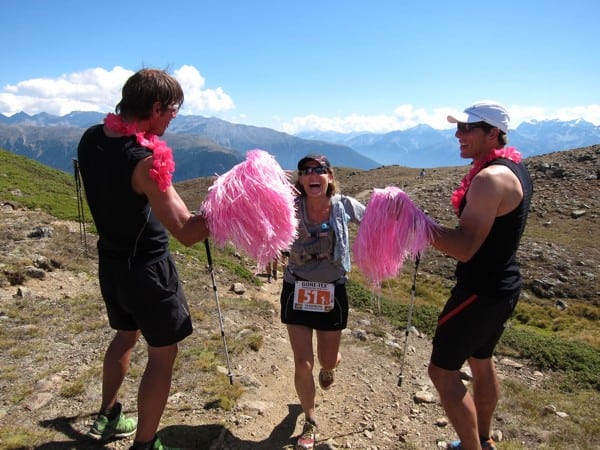
Tia passing two cheerleaders during the 2013 Transalpine-Run in Germany. Photo: Erick Kasiulis
One goal each year is to make the race internationally welcoming. “It is fun to see how other cultures do this sport and being on the trails with different types of runners,” she said. “We all have a core value of running in nature. I have a team from Panama who always comes and a few women from Japan.”
International races such as Marathon des Sables in Morocco, which she ran in 2010, and the Gore-Tex Transalpine-Run in Germany, which she ran in 2013, are the type of races that feed Tia’s personal love of tough adventures.
Over the last few months, prioritizing training and racing has not been at the top of her list. Classes and her daughter’s Austin, Texas wedding have kept the busy runner off the trails. “I can go for a run or I can hem my daughter’s wedding dress,” she said. “What do you think I’m going to do?” A DNF at this year’s Western States and the Pine to Palm 100-Mile Endurance Run additionally reminded Tia that her 50-some-odd-year-old limbs need more training than what she used to be able to get away with. But they were also fuel to get her going again, and in 2016 she already has several races planned.
Ironman Houston in May of 2016 is her next race, and a good change to the constant running miles needed for an ultra. The Courmayeur-Champex-Chamonix (CCC), the 100k distance of the Ultra-Trail du Mont-Blanc race series, and some stage races are also on her to-be-run list.
Planning these bucket-list races revolves around the status of Miwok, which will always be a top priority in Tia’s life. Right now it is October, when people are thinking about pumpkins, fall marathons, and dreading pulling out their winter running clothes.
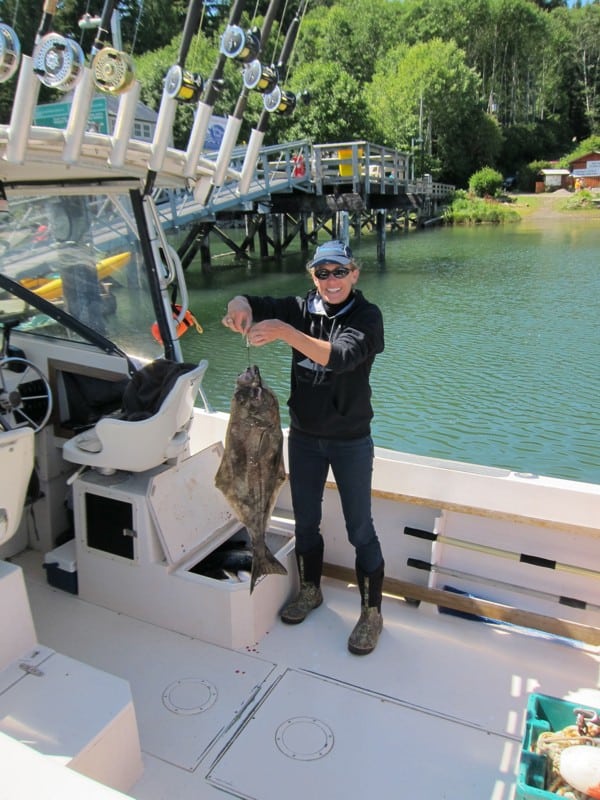
Tia fishing in Canada. Photo: Erick Kasiulis
Tia’s mind is focused on May 7, 2016, Miwok race day. Inside her brain are things like: the race’s new Salomon sponsorship, taking care of poison oak, and the race’s new website. “I am already working on permits,” she said. “The lottery is in December, so I have many hours and meetings negotiating permits with the parks.”
In January through May, she will spend about 20 hours a week on volunteers, race details, course markings, and a million other jobs. And June is full with follow-ups and clean-ups.
By August, the runner, mother, and race director is ready for a Miwok break. “Anything to do with Miwok will have to wait,” she said, once August hits and free time returns to her schedule. Reading, cooking, and gardening substitute the ultra world for a bit, but will never replace it.
When looking at Tia’s UltraSignup profile, one’s eyes scroll among races all over the West, of all different distances, and of different reputations. One thing stands out among her list of races run: diversity. For someone who has been running ultras since 2000, repeats are common, but Tia is loves new experiences. “Every race I’ve run, I’ve enjoyed,” she said. “But I like having new experiences, so I don’t tend to go back.”
While the Miwok 100k may take place every year and within the same place in California, directing 62 miles with over 500 dedicated runners and a passel of volunteers with the changing conditions of the trail won’t ever offer Tia the same experience twice.
Call for Comments (from Meghan)
- Have you run Miwok since it’s been under Tia’s direction? Can you share a story about Tia and her race?
- Have you shared the trails with Tia in another race? What do you remember about your time with her?

Tia running through the mountains of Germany’s Transalpine-Run. Photo: Sportograf Photography
